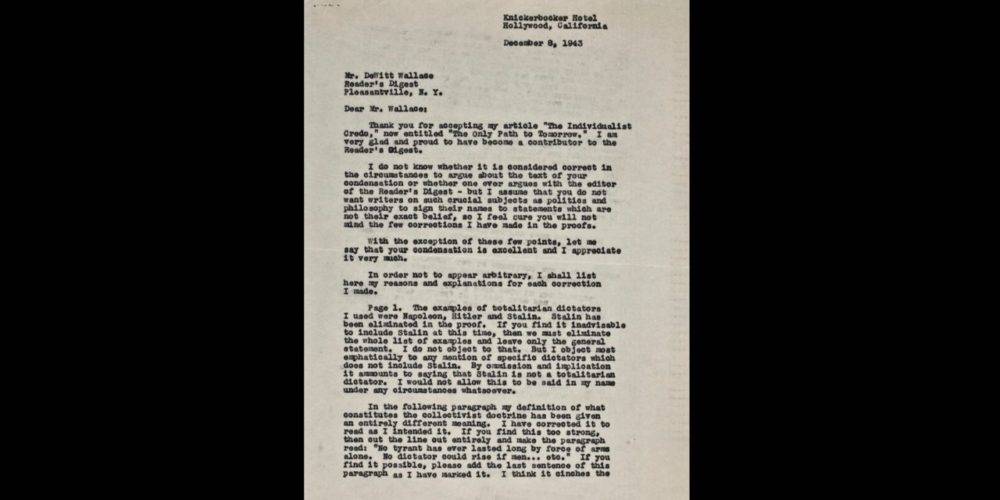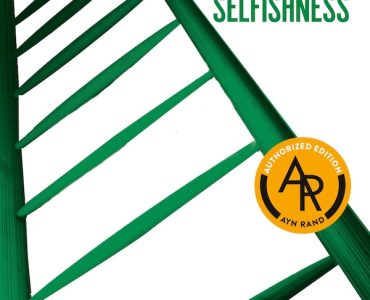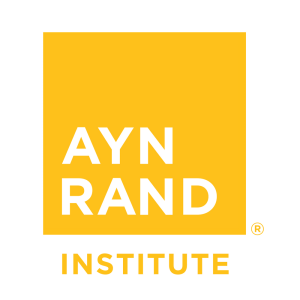“I have always maintained that ideas must be treated with the same scrupulous precision as financial matters or legal documents,” wrote Ayn Rand to a newspaper editor in 1961. “I take an enormous amount of time, effort and thought on the formulation of my ideas.”1 As an illustration of what she meant, here is how Rand described her work on the screenplay for her novel The Fountainhead, in a letter to her agent:
You realize, of course, that [Howard Roark’s] speech had to be written as carefully as a legal document. I had to weigh every word, every thought — in order not to leave any loopholes which would permit anyone to accuse us of some improper ideology. I had to make every idea crystal clear, cover every possible implication, guard against any chance of misunderstanding, avoid any possibility of confusion. I did it — and preserved the dramatic and literary qualities of the speech at the same time. You understand the problems of writing. Try to imagine what sort of effort this took.2
The published results of Rand’s efforts speak for themselves — but how did she do it? What thinking methods guided her writing process?
We know that one of her basic principles, elucidated in a 1974 essay, was to take ideas seriously. This means attaching “clear, specific meanings to words” and identifying exactly what the words refer to in reality:
Take it literally. Don’t translate it, don’t glamorize it, don’t make the mistake of thinking, as many people do: “Oh, nobody could possibly mean this!” and then proceed to endow it with some whitewashed meaning of your own. Take it straight, for what it does say and mean.3
Like her fictional hero Roark — an architect who proudly declared that “my botches end up in my own wastebasket” — Rand labored diligently in the privacy of her study, editing for clarity and discarding her missteps. Much can be inferred about her methods from analyzing the changes she made to her manuscripts.4 She also explained the methods that guided her nonfiction writing process in a course that has been transcribed and edited into book form.5 But there’s another window through which we can glimpse her mind at work. In correspondence, Rand discussed her thinking methods explicitly in two contexts: when dealing with editors who sought to alter her submissions, and when dealing with writers whose work she was critiquing. In these situations she spoke at length in applying her principles to specific cases.
Let’s look at a few examples.
Disagreements with Reader’s Digest
Rand’s article “The Only Path to Tomorrow” appeared in the January 1944 issue of Reader’s Digest magazine. By comparing three documents — Rand’s original draft, the edited version, and her correspondence with the magazine — we can see in concrete detail what it meant for her to take ideas seriously.
The article’s theme was that individualism and freedom are the proper alternatives to the collectivist totalitarianism that had plunged the world into war. Drawing on themes from The Fountainhead, published the previous year, Rand submitted three paragraphs contrasting the “Active Man” — the independent-minded individualist who produces, innovates and carries mankind forward — with the “Passive Man” — the parasite who dreads independence and welcomes collectivist control of his life. One sentence in those paragraphs reads:
When a society is based on the needs of the Passive Man it destroys the Active; but when the Active is destroyed, the Passive cannot survive.
A Reader’s Digest editor changed the ending to:
“. . . the Passive can no longer be cared for.”
Rand objected to the edit because it “sounds as if I advocate that the Passive must be cared for, that it is our duty. I do not; when I say, as I marked, ‘the Passive cannot survive’ it is a simple statement of fact, without altruistic implications.”
Rand’s antagonism to “altruistic implications” stemmed from her then-new and controversial insight that altruism is an evil morality. In The Fountainhead, she had portrayed altruism, not as benevolence or kindness toward one’s neighbors, but as a moral code holding that man has no right to live for his own sake, that his highest value and virtue consist in serving others and sacrificing his own interests for their sake. This moral principle she utterly rejected — but the edit implied the opposite, hence her objection.
In that same article, Rand had included a paragraph about totalitarian dictators that gave as examples Napoleon, Hitler and Stalin. An editor removed all references to Stalin, perhaps out of concern that Russia was at the time an ally of the United States in World War II. Rand was sensitive to the possibility that “you find it inadvisable to include Stalin at this time.” But if that were the case, she insisted, all references to Napoleon and Hitler should be deleted as well. “I object most emphatically to any mention of specific dictators which does not include Stalin. By omission and implication it amounts to saying that Stalin is not a totalitarian dictator.”
In another passage from the same article, Rand’s original manuscript read as follows:
Individualism holds that man is an independent entity with an inalienable right to the pursuit of his own happiness in a society where men deal with one another as equals in voluntary, unregulated exchange.
A Reader’s Digest editor removed the last four words:
Individualism holds that man is an independent entity with an inalienable right to the pursuit of his own happiness in a society where men deal with one another as equals.
Rand objected: “To say ‘where men deal with one another as equals’ is a generality to which even a communist could subscribe. The whole point of my statement is the end of the sentence: ‘in voluntary, unregulated exchange.’ Since individualism is my whole theme, religion and mission in life, you can understand why I want to give the best definition I can, and why I do not want to sound as if, at the most crucial point, I got away with a mere generality.”
As in the previous cases, Rand was trying to advance a new and controversial concept. In this case, it was a radical concept of individualism that allowed no government constraints on trade. Rand knew that the deleted language was crucial for making her idea explicit to readers.
Finally, in her original manuscript Rand had written:
We must learn to reject as total evil the conception that “the common good” is superior to individual rights.
An editor removed the “scare quotes” and added a phrase:
We must learn to reject as total evil the conception that the common good is served by the abolition of individual rights.
Rand explained her objections in detail:
My statement on what we must reject as total evil has been given an entirely different meaning. As the statement stands in the proof, it amounts to my saying that I would tolerate the abolition of individual rights if it really served the common good, but that I object to it only because it doesn’t. This is not my belief at all. In fact, this is the point on which our entire conservative side has ruined its stand. My belief is that I would not tolerate such an abolition for any cause and in any circumstances whatsoever. This is the heart of my whole article. Therefore, the statement must read as I marked it. By putting the words “common good” in quotes, we will avoid the impression which I believe your editors had in mind or were afraid of when they changed this sentence.
At this point, one might muster some sympathy for the poor Reader’s Digest editor. He probably didn’t guess, when he awoke the day he would edit Rand’s article, that a relatively unknown author would be championing, not one or two, but four very controversial moral positions in one article. Altruistic duty, Stalin’s dictatorship, economic regulation and the sacrifice of individual rights to the “common good” — Rand regarded them all as evils. Acting on the premise that a writer must take ideas seriously, Rand did her best to achieve clarity in the editing process at Reader’s Digest. Her concise explanations can serve as a model for writers and editors.6
Critiques of others’ writing
Rand’s techniques for taking ideas seriously also featured prominently in correspondence with writers whose work she critiqued. One of these writers was free-market advocate Leonard Read, creator of the Foundation for Economic Education and The Freeman magazine. Read frequently invited Rand’s comments on his writing; both of them affectionately referred to her as his “loyal ghost.”
For example, in a paper called “The Scope of Economics and of Economic Education,” Read had written that communism and other forms of totalitarianism restrict economic opportunity “for at least a part of the citizenry.” Rand objected to the implication of his statement: “Which part of the citizenry is not restricted under Communism? Do you mean to imply that Commissars have freedom of enterprise?”7
Elsewhere, in a speech called “Dealing with Collectivism,” Read had said:
No true lover of liberty will admit that there is another side to the case [for a voluntary society]. He may admit that he does not know how to accomplish everything by voluntary methods, but his thinking will be aimed at finding out.8
In her critique, Rand objected at length:
The second sentence of this paragraph is a blatant denial of the first. It is an admission that there are things which we should accomplish, and which can be accomplished by coercion, but not by voluntary methods. What are these things? There is not a single issue, objective or purpose — and I mean none whatever — which is desirable but cannot be accomplished by voluntary methods. . . .
That sentence in your speech is an admission that coercive methods work sometimes for good purposes and with good results. Surely, you do not believe that. If you do, it is a loophole through which a collectivist can destroy your whole case. Once you grant him that some proper objective can be accomplished by force, the rest of the argument becomes merely a squabble over which objectives you or he will consider proper. You have granted him his premise.
In that same speech, Read had said that the lover of liberty “knows that coercion is destructive except when it is used as police force to prevent interferences with personal liberty.” In her critique, Rand objected and explained her reasons:
Also, the last sentence of your paragraph which I quoted is extremely inaccurate and bad in its implications. You describe the police power of the government as the power of coercion, and you place it in the same category as any other coercion exercised by a government. That is not correct. What the government does in regard to criminals is not coercion; it is not an action, but a reaction; the use of force to answer force. The use of force here is not initiated by the government but by the criminal. Therefore, it is not the same thing (and does not rest on the same principle) as the action of a government initiating the use of force for some “social” purpose of its own.
I cover this very point in the second installment of my TEXTBOOK OF AMERICANISM. I would suggest that you read very carefully my questions #7 and #8. I think the definitions I give there cover the case — and it is extremely important for our side not to mix the proper police powers of the government with its usurped powers of economic coercion. This is a crucial point which collectivists are using to the hilt; one of their most frequent arguments goes like this: “If the government has the right to seize criminals, it also has the right to seize you.” We must not help them spread that kind of confusion.
I most emphatically do not believe that the philosophy set forth in the Constitution of the United States is a “Democratic philosophy,” and I do not hold a “Democratic” philosophy, if one uses that word correctly. Nowadays, the word “Democratic,” like the word “liberal,” has lost all specific, objective meaning. It has become a rubber word which every person stretches to mean whatever he wishes it to mean. But since we are an organization of writers, we, above all people, should use words in their exact meaning. Historically and philosophically, a democratic philosophy means a belief in unlimited majority rule (total rule by the majority, unlimited by any individual rights). This is not the philosophy on which the Constitution was based. The United States is a Republic, not a Democracy. If proof is needed, here is a quotation from THE FEDERALIST: “Such democracies (pure democracies) have ever been spectacles of turbulence and contention; have ever been found incompatible with personal security of the rights of property; and have in general been as short in their lives as they have been violent in their deaths.”9
As a radical thinker, Ayn Rand faced special challenges in writing. Because her ideas were both new and controversial, she knew that her readers needed all the help she could give them to grasp her meaning. She made it her business to use language precisely, to remain constantly aware of ambiguities, multiple meanings, hidden premises, and other faults that could cause confusion in a reasonable reader’s mind. Because her goal was clear communication, she knew that she risked failure if flaws in writing led her audience astray.
Ayn Rand eloquently summarized her approach to writing in the letter with which this article started: “I had to make every idea crystal clear, cover every possible implication, guard against any chance of misunderstanding, avoid any possibility of confusion.” That attentiveness to precision guided her entire writing career. In every way possible, she took ideas seriously.
(Note: These letters, owned by Leonard Peikoff, are part of Ayn Rand Papers collection. Their reproduction here is courtesy of the Ayn Rand Archives.)
Readers seeking a superior print result may wish to download the free Just Read app.
Do you have a comment or question?
Endnotes
- Letter to the editor of the Commercial & Financial Chronicle, May 26, 1961.
- Letter to Alan Collins from Ayn Rand dated September 18, 1948.
- Ayn Rand, “Philosophical Detection,” Philosophy: Who Needs It (New York: Signet, 1984 Centennial edition), 16.
- Shoshana Milgram’s articles have set the standard for scholarship here: “Anthem in Manuscript: Finding the Words,” in Robert Mayhew, ed., Essays on Ayn Rand’s “Anthem” (Lanham, MD: Lexington Books, 2005); “From Airtight to We the Living: The Drafts of Ayn Rand’s First Novel,” in Robert Mayhew, ed., Essays on Ayn Rand’s “We the Living” (2nd ed.) (Lanham, MD: Lexington Books, 2012); “The Fountainhead from Notebook to Novel: The Composition of Ayn Rand’s First Ideal Man,” in Robert Mayhew, ed., Essays on Ayn Rand’s “The Fountainhead” (Lanham, MD: Lexington Books, 2007); “Who Was John Galt? The Creation of Ayn Rand’s Ultimate Ideal Man,” in Robert Mayhew, ed., Essays on Ayn Rand’s “Atlas Shrugged” (Lanham, MD: Lexington Books, 2009).
- Ayn Rand, The Art of Nonfiction (New York: Plume, 2001).
- Unfortunately, Reader’s Digest did not receive Rand’s responses in time, and the essay was published with the edits she had objected to. Ayn Rand, “The Only Path to Tomorrow,” Reader’s Digest, January 1944. “They pulled all the teeth out of it,” she wrote to a correspondent. Letter dated February 1, 1944, from Rand to Leonard Read, Ayn Rand Papers, 139_F1x_020_001. See also commentary by Michael S. Berliner on letter dated December 8, 1943, from Ayn Rand to DeWitt Wallace, the magazine’s co-founder.
- Letter dated April 16, 1946, from Ayn Rand to Leonard Read, in Michael S. Berliner, ed., Letters of Ayn Rand (New York: Dutton, 1995), 274.
- Letter dated July 17, 1946, from Ayn Rand to Leonard Read.
- Letter dated February 12, 1949, from Ayn Rand to Edna Lonigan.







